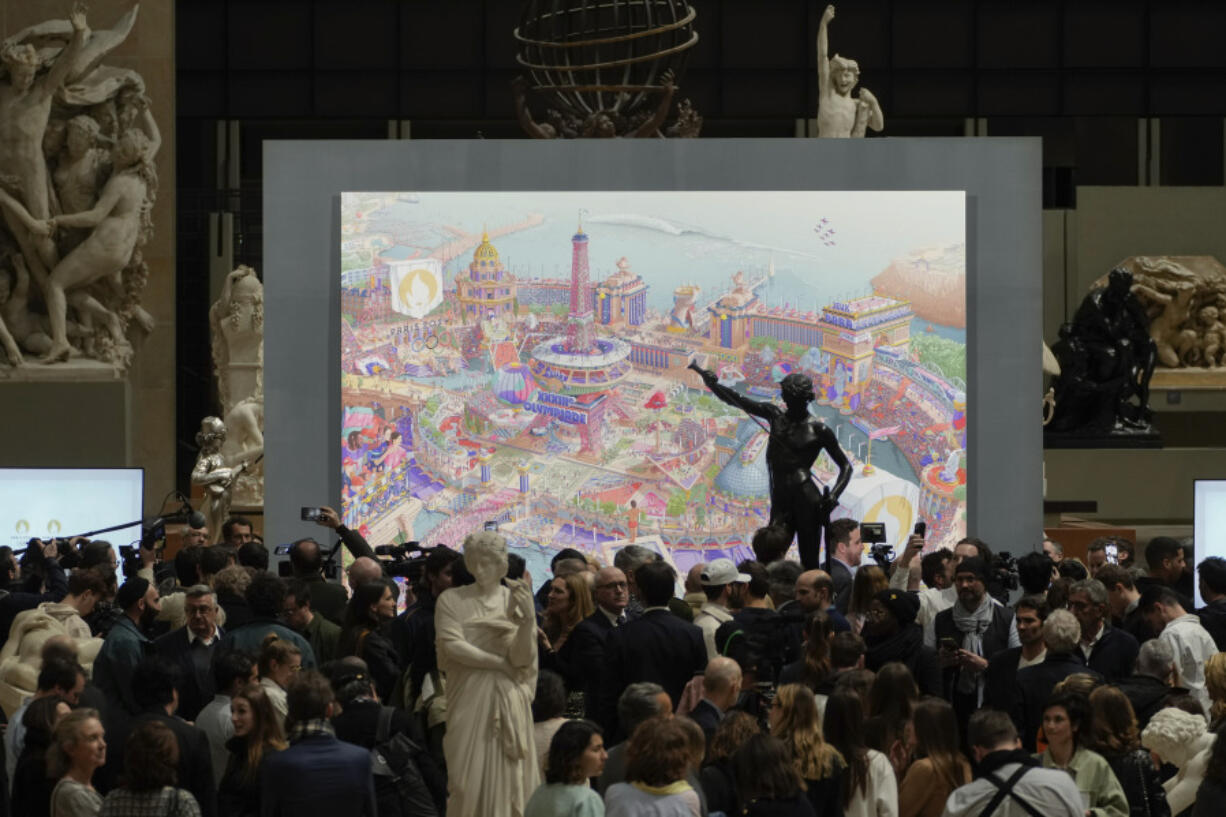PARIS — Vibrant colors and striking landmarks illuminate posters for the Paris Olympic Games in an art deco style inspired by the city’s flamboyant past.
The posters were unveiled on Monday at the Musée d’Orsay — a former railway station transformed into an imposing museum stretching along the Seine River — in the presence of Paris 2024 director of design Joachim Roncin and the artist behind them, Ugo Gattoni.
“I don’t want it to be something dull like only a poster with only a logo and a date on it, which they usually are. I want to tell a story,” Roncin told The Associated Press in an interview from the artist’s studio prior to the unveiling. “I want it to be something very happy, because it’s going to a huge party. I want it to be very joyful. Hopefully people will be inspired by these posters.”
There are many eye-catching images to absorb.
Among the most striking is the Eiffel Tower piercing through the Stade de France. As if forming a giant cake mixing together two crucial ingredients: Paris’ most famed landmark and its national stadium.
Spectators on the posters have expressions on their fresh faces that are perfectly captured. It’s like they are frozen in time, enjoying a giant and timeless party somewhere: On a balcony admiring ballroom dancers, or guests at a grandiose fête thrown by the Great Gatsby himself.
“It’s the art deco style,” Roncin said. “I wanted something very flamboyant, very rich, very colorful. It’s typical of Paris, when you look at various restaurant styles, you can see the art deco style. When you look at the entrance on the subways, you can see the art nouveau style.”
No coincidence that it has this feel, perhaps, since these Games mark the centenary of the 1924 Olympics in Paris.
Everywhere you look, even amid a blur of colors, the details are intricate and precise.
In the background you can see the Olympic flame arriving on a three-mast tall ship into the French port of Marseille, having sailed from Greece, and the high-rolling waves representing surfing events in Tahiti. Closer up, some of Paris’ monuments which will be used during both Games.
Les Invalides, which holds former French emperor Napoléon Bonaparte’s tomb; the imperious Grand Palais; the Arc de Triomphe, and the Château de Versailles, whose resplendent gardens will host equestrian and pentathlon events.
Roncin said 15,000 to 30,000 posters for the July 26-Aug. 11 Paris Games and the Aug. 28-Sept. 8 Paralympics will be sold. Prices range from 20 euros ($22) for the smallest size (30×40 centimeters/12×16 inches), 30 euros ($33) for the medium (50×70 centimeters/20×27 inches) and 40 euros ($43) for the largest (60×80 centimeters/24×32 inches).
The posters will also appear on billboards all over Paris from Tuesday.
It will be a relief to purists that no AI (artificial intelligence) was used to design the posters, which is part of the reason why Roncin selected Gattoni.
“It was very important to work with Ugo because he’s a manual artist, he works with his hands. Nothing is digital assisted. Today we live in the world where there is a lot of AI,” Roncin said. “I wanted to bring this savoir-faire à la française (French know-how); to do these hand-drawn posters and colors as well, with the hand.”
It took six months to decide which colors to use and Gattoni has spent more than 2,000 hours working on the posters.
“It has this fresh feel … an atmosphere of good vibes,” said Gattoni, whose work also included studying all the previous Olympic posters.
“Just like the 1924 poster, this poster has to work in 100 years’ time. For me this is super important.”
The first official Olympics poster appeared for the 1912 Games in Stockholm and was chosen through an artistic competition. Since then posters have been the responsibility of organizers in the host city.
In the first half of the 20th century, a limited number of posters were designed and used for communication and promotional purposes in a pre-radio and pre-television era, giving the general public necessary practical information.
In the second half of the century, the number of posters produced increased.
They reflected the artistic, political and social context of their era as the Olympics also branched out of Europe and North America toward Oceania, Asia and Central America.
According to the Olympic Studies Center, at this point “they play a double role: In addition to announcing the Games, they provide a foretaste of their visual identity.”
Gattoni says it’s the first time he’s drawn “so many humans” and describes his style as creating a universe — one which sucks people in.
“To dive into this universe and become part of it,” Gattoni said. “The drawing is so detailed that you can imagine yourself walking through the gardens of Versailles.”
One of the poster’s most captivating scenes is an athlete standing on a diving platform with arms outstretched, the Olympic dove softly perched on his left arm.



